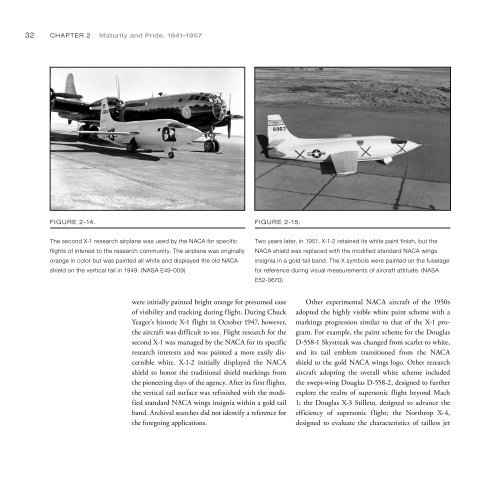Create successful ePaper yourself
Turn your PDF publications into a flip-book with our unique Google optimized e-Paper software.
32 CHAPTER 2 Maturity and Pride, 1941–1957<br />
FIGURE 2-14.<br />
FIGURE 2-15.<br />
The second X-1 research airplane was used by the NACA for specific<br />
flights of interest to the research community. The airplane was originally<br />
orange in color but was painted all white and displayed the old NACA<br />
shield on the vertical tail in 1949. (NASA E49-009)<br />
Two years later, in 1951, X-1-2 retained its white paint finish, but the<br />
NACA shield was replaced with the modified standard NACA wings<br />
insignia in a gold tail band. The X symbols were painted on the fuselage<br />
for reference during visual measurements of aircraft attitude. (NASA<br />
E52-0670)<br />
were initially painted bright orange for presumed ease<br />
of visibility and tracking during flight. During Chuck<br />
Yeager’s historic X-1 flight in October 1947, however,<br />
the aircraft was difficult to see. Flight research for the<br />
second X-1 was managed by the NACA for its specific<br />
research interests and was painted a more easily discernible<br />
white. X-1-2 initially displayed the NACA<br />
shield to honor the traditional shield markings from<br />
the pioneering days of the agency. After its first flights,<br />
the vertical tail surface was refinished with the modified<br />
standard NACA wings insignia within a gold tail<br />
band. Archival searches did not identify a reference for<br />
the foregoing applications.<br />
Other experimental NACA aircraft of the 1950s<br />
adopted the highly visible white paint scheme with a<br />
markings progression similar to that of the X-1 program.<br />
For example, the paint scheme for the Douglas<br />
D-558-1 Skystreak was changed from scarlet to white,<br />
and its tail emblem transitioned from the NACA<br />
shield to the gold NACA wings logo. Other research<br />
aircraft adopting the overall white scheme included<br />
the swept-wing Douglas D-558-2, designed to further<br />
explore the realm of supersonic flight beyond Mach<br />
1; the Douglas X-3 Stilleto, designed to advance the<br />
efficiency of supersonic flight; the Northrop X-4,<br />
designed to evaluate the characteristics of tailless jet


